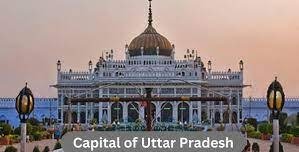Understanding Uttar Pradesh: Exploring the Heartland’s Capital
Uttar Pradesh, a state known for its rich cultural heritage, diverse traditions, and historical significance, holds a prominent place in the heart of India. Aspirants preparing for various government exams, especially those targeting roles in teaching, law enforcement, banking, railways, defense, and civil services, must grasp the fundamental aspects of Uttar Pradesh. In this article, we delve into the significance of Lucknow, the capital city of Uttar Pradesh.
Lucknow, situated along the banks of the Gomti River, boasts a unique blend of ancient grandeur and modernity. Its historical significance dates back centuries, marking eras of Mughal and British rule. The city’s architecture, reminiscent of the Nawabi era, showcases a splendid fusion of Islamic and European styles, reflected in its iconic monuments like the Bara Imambara, Chota Imambara, and the Rumi Darwaza.

Why this News is important:
Historical and Cultural Relevance
Lucknow’s historical and cultural relevance transcends time, offering aspirants a glimpse into the state’s intricate past, pivotal for comprehensive exam preparation.
Importance in Administrative Context
For aspirants vying for government positions, comprehending Lucknow’s administrative role as Uttar Pradesh’s capital is crucial. Understanding its political, economic, and social significance aids in answering exam questions related to governance.
Historical Context:
Lucknow’s legacy dates back to the 18th century, when it emerged as a prominent cultural and artistic hub under the Nawabs of Awadh. It thrived as a center of Urdu poetry, music, and etiquette, fostering a refined lifestyle that persists in its essence today.
Key Takeaways from “Capital of Uttar Pradesh”:
| Serial Number | Key Takeaway |
|---|---|
| 1. | Lucknow, nestled by the Gomti River, is UP’s capital city. |
| 2. | Rich cultural heritage – Nawabi architecture & traditions. |
| 3. | Historical significance: Mughal & British rule influence. |
| 4. | Administrative importance in the context of the state. |
| 5. | Key landmarks: Bara Imambara, Chota Imambara, Rumi Darwaza |
Important FAQs for Students from this News
Q: What makes Lucknow significant in Uttar Pradesh’s history?
A: Lucknow holds significance due to its historical legacy under the Nawabs of Awadh, showcasing cultural richness and administrative importance.
Q: Which landmarks highlight Lucknow’s architectural marvels?
A: Landmarks like the Bara Imambara, Chota Imambara, and Rumi Darwaza exemplify Lucknow’s architectural grandeur.
Q: How does understanding Lucknow benefit government exam aspirants?
A: Knowing Lucknow’s historical, cultural, and administrative importance aids in answering questions related to the state’s governance and heritage.
Q: How did Lucknow gain its cultural prominence during the Nawabi era?
A: Lucknow flourished culturally during the Nawabi era due to the patronage of arts, literature, music, and etiquette by the Nawabs, creating a sophisticated and refined society.
Q: What is the significance of Lucknow’s architectural fusion?
A: Lucknow’s architectural fusion represents a blend of Islamic and European styles, showcasing the city’s unique cultural amalgamation during different historical periods.
Some Important Current Affairs Links

















